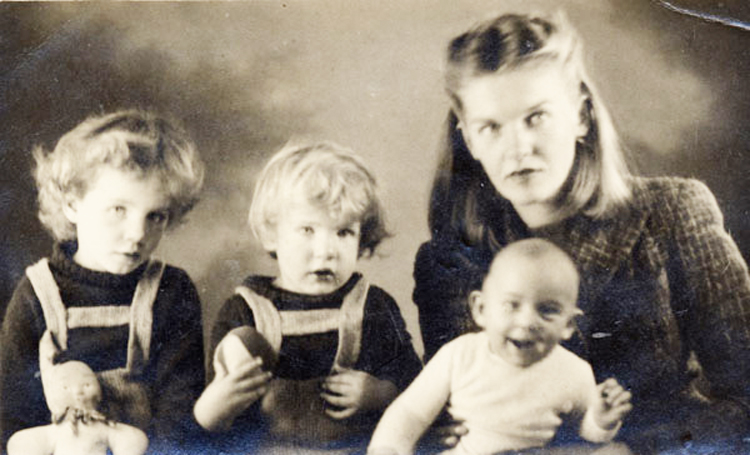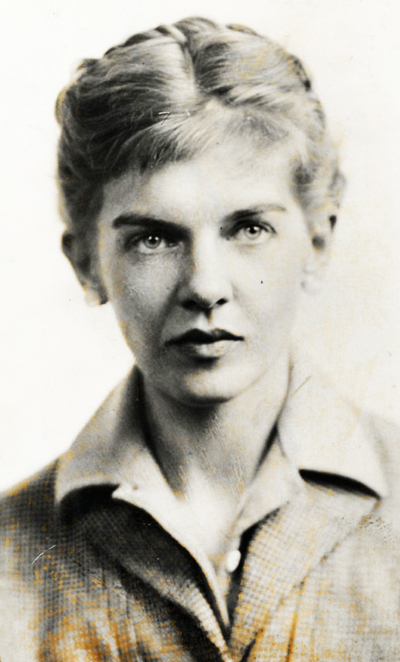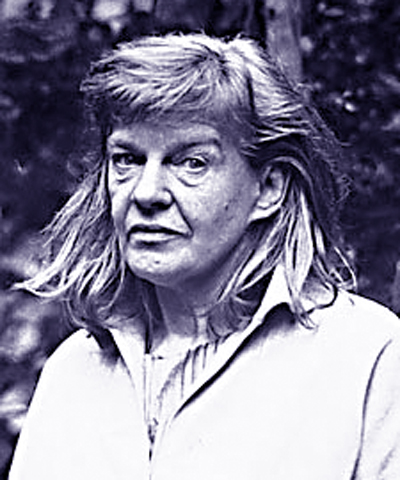#5 Elizabeth Smart
April 08th, 2015

LOCATION: St. Mary’s Hospital, 4339 Garden Bay Road, Pender Harbour.
Renovated and re-opened as the Sundowner Inn in 1964, the original St. Mary’s Hospital opened in Garden Bay on August 16, 1930, thanks largely to the efforts of John Antle, head of the Coast Columbia Mission. In 1953, St. Mary’s turned over to a local board of directors. The existence of this remote hospital was the reason Elizabeth Smart came to Pender Harbour, where she wrote her slim but classic novel, By Grand Central Station I Sat Down and Wept. She wanted to be near a hospital when she gave birth to her out-of-wedlock child.
QUICK REFERENCE ENTRY:
Lonely, single, pregnant but above all fiercely in love—perhaps with love itself—Elizabeth Smart stepped off the steamer Lady Cynthia at Irvine’s Landing in Pender Harbour, B.C., in April of 1941. The world was at war and she sought solitude.
Eight months later she left Pender Harbour, having produced her first-born child, Georgina Barker, fathered by poet George Barker, as well as her rhapsodic lament entitled By Grand Central Station I Sat Down and Wept (1945). Smart’s unusual upper class background and her bohemian lifestyle has charmed and appalled readers ever since. Smart’s lifelong, masochistic devotion to the Englishman George Barker–by whom she bore four children without ever living with him–was either staunchly heroic or downright daft. Take your pick.
Born to an affluent family in Ottawa in 1913, Smart was sent to London to be educated. There she picked up a small book of poetry by George Barker, a protegé of T.S. Eliot, and, as the story goes, decided then and there, sight unseen, that she would marry him and have his children. Along the way she met the likes of Henry Miller and Picasso, and lost her virginity to the flamboyant and arrogant painter Jean Varda in Cassis, France.
In Mexico, Smart attended a birthday party of the renowned Mexican muralist Diego Rivera and had an affair with Alice Paalen. Varda showed up in Mexico and he and Smart ended up living together in Big Sur, California, in an artists’ colony. In California, Smart wrote a novella based on her lesbian experiences with Paalen entitled “Dig A Grave and Let Us Bury Our Mother.” It would appear in In The Meantime (1984).
Smart had previously been in touch with poet George Barker, buying an original manuscript and exchanging letters. Smart had sent some poems to Lawrence Durrell in 1938 and he had suggested Smart and Barker should meet—because Barker, who was teaching in Japan, was short of money. Barker approached Smart for funds to flee the country. Smart met him in Monterey and was taken aback to discover he had his wife with him. It is this scene which opens By Grand Central Station I Sat Down and Wept. Despite the presence of Mrs. Barker in Mexico, the pair were soon having an intense affair which resulted in Smart’s first pregnancy.
In Pender Harbour, Smart lived in one of three shacks near the mouth of the harbour and painted her door yellow, adding a line from William Blake’s The Marriage of Heaven and Hell above it, “The cut worm forgives the plough.” Barker visited briefly early in her pregnancy. She made a few friends, the most remarkable being Vienna-born Maximiliane Von Upani Southwell (“Maxie”), some 20 years her senior.
As Smart’s pregnancy and manuscript neared completion, Maxie took her in, despite her own poverty, and assisted her. Elizabeth Smart, in return, dedicated By Grand Central Station I Sat Down and Wept to Maxie. When Barker tried to visit Smart a second time during the pregnancy, Smart’s mother used their Ottawa connections to keep him out of Canada. Barker was stopped at the border.
The love child was born in August and Smart left Canada on December 7, 1941—the day Japan attacked Pearl Harbour—leaving the infant with Maxie in order to meet up with Barker.
He failed to meet her at Grand Central Station.
“A pen is a furious weapon,” she later wrote, in Rogues & Rascals, “But it needs a rage of will. Everything physical dies but you can send a mad look to the end of time.”
Elizabeth Smart left Canada for England in 1984 and died there at age 72, two years later.
Elizabeth Smart once said, “It’s a natural feeling to want to have a baby when you’re really in love. Every woman feels it and I think men do, too, when they’re really involved. A woman is a man with a womb, that’s what the word means. It’s not a man without something, it’s a man with something and that something is a womb. I wanted these female experiences.”
FULL ENTRY:
Lonely, single, pregnant but above all fiercely in love, perhaps with love itself, Elizabeth Smart stepped off the steamer Lady Cynthia at Irvine’s Landing in Pender Harbour, B.C. in April of 1941; the world was at war and she sought solitude. Eight months later she left, having produced her first born, Georgina Barker, along with a remarkable novel/memoir entitled By Grand Central Station I Sat Down and Wept. Her personality, like her writing, was controversial. Smart seemed to either completely captivate people with her charm and unusual upper class/Bohemian lifestyle, or alienate others due to her masochistic devotion to English poet George Barker–by whom she bore four children without ever living with him–or her excessive use of alcohol to medicate an anguished part of her psyche centred around rejection by her mother. It has been said that in her own histrionic way, she helped manufacture a myth surrounding her life and writing, often exaggerating or bending the truth to achieve the desired effect.
Elizabeth Smart was born in Ottawa to a fairly affluent family on December 27, 1913. They entertained the likes of Lester B. Pearson, Sir Stafford and Lady Cripps, CBC founder Graham Spry and British prime minister Ramsay MacDonald. Their cottage in the Gatineau hills was next door to Prime Minister MacKenzie King’s cottage. They were included in the society pages of the time. Smart was sent to private schools and, upon graduation, went to study in London, England. There she had a relationship with Lord John Pentland, attended the King’s coronation and partied at Buckingham Palace. It was also in England that she picked up a small book of poetry by George Barker, a protégé of T.S. Eliot’s, and supposedly decided then and there, sight unseen, that she would marry him and have his children.
But there were a few diversions along the way. In 1938 at a party she met Jean Varda, a flamboyant and arrogant painter of Greek origins who lived in a run-down, 22-room mansion in Cassis, France. Smart was invited to accompany Varda and a group of friends to Cassis. Others who had stayed there were Picasso, Braque and Miro. Henry Miller was a big fan of Varda who also attracted the attention of the ladies. It was here with Varda that Smart is said to have had her first sexual experience. Eventually stifled by Varda, she went to Mexico to escape and visit friends Wolfgang and Alice Paalen. He was a surrealist painter she had met in Paris. While in Mexico, Smart attended, with the Paalens, the birthday of renowned Mexican muralist Diego Rivera. The Paalens were living in a menage a trois with a Swiss friend. Both women were supportive of the needy artist “like a pair of crutches”. Wolfgang Paalen attempted to entice Smart to the same role but she rebuffed his advances. Smart did, however, have a lesbian relationship with Alice Paalen, who Anais Nin described to Henry Miller as looking “like a Mexican-Indian woman”. Varda showed up in Mexico and he and Smart ended up living together in Big Sur, California in an artists’ colony, even though she was becoming less and less enthralled with his charm. In California, Smart wrote a novel based on her lesbian experiences with Paalen entitled Dig A Grave and Let Us Bury Our Mother. It would appear posthumously, edited by Alice VanWart, as In The Meantime in 1984.
Smart had previously been in touch with poet George Barker, buying an original manuscript and exchanging letters. Smart had sent some poems to Lawrence Durrell in 1938 and he had suggested Smart and Barker should meet–because Barker was short of money. At this point, with Barker teaching in Japan and Japan about to enter the war, Barker approached her for funds to flee the country. The money was raised. Smart met him in Monterey and was taken aback to discover he had his wife with him. It is this scene which opens By Grand Central Station I Sat Down and Wept. Smart found a wooden hut in the wilds of Big Sur, California where they lived as friends until the inevitable happened. In the novel she wrote, “Under the waterfall he surprised me bathing and gave me what I could no more refuse than the earth can refuse the rain.” Despite the presence of Mrs. Barker, the pair were soon having a sexual affair which resulted in Smart’s pregnancy. Eventually they came to Canada, were rebuffed by her Ottawa family and ended up in Vancouver in a run-down hotel room with very little money, a state Barker found himself in for most of his life. Just how she came to choose Pender Harbour to have her child and write her famous novel is a bit of a mystery. She later stated she just stuck a pin in a map and got on the steamship. But in her diaries at the time, it is evident she had been in Pender Harbour previously for a holiday with Barker and an affluent American friend with whom Barker left Smart and Canada. In 1982 Smart told an interviewer that Barker had 14 ‘conspicuous children’ and as many as 35 in total, but she was known to exaggerate for effect.
Smart’s time in Pender Harbour was uneventful. She lived in one of three shacks near the mouth of the harbour and painted her door yellow, adding a sign above it, ‘The cut worm forgives the plough’. Reading Rilke in a tiny logging and fishing community, she was an outsider who was linked to the outside world by the little post office. Barker arrived for a visit early in her pregnancy. For some reason the RCMP appeared on her doorstep one day and found her to be a “religious maniac”. She made a few friends, the most remarkable being Vienna-born Maximiliane Von Upani Southwell, some 20 years her senior. As Smart’s pregnancy and manuscript came near completion, Maxie took her in, despite her own poverty, and assisted her. Elizabeth Smart, in return, dedicated By Grand Central Station I Sat Down And Wept to Maxie. When Barker tried to visit Smart a second time during the pregnancy, Smart’s mother used their Ottawa connections to keep him out of Canada. Barker was stopped at the border. Elizabeth Smart used her own Ottawa ties to get Barker a job at the British Army Office in Washington. After their child was born in August, Smart left Canada on December 7, 1941–the day Japan attacked Pearl Harbour–leaving Georgina with Maxie in order to meet up with Barker. He failed to meet her at Grand Central Station.
Smart connected with Barker, taking a clerical job in the British Army Office in Washington, D.C. When she gained a promotion to the Information Office of the British embassy, she reclaimed Georgina. Pregnant again, she sailed for England in a convoy in 1943, this time to escape from Barker. Her ship was torpedoed but stayed afloat. “A consenting adult moves on…” she once wrote. Upon her arrival, Smart was told her transfer to a new job in London would not be honoured due to her ‘condition’. In England, Smart set about establishing herself as a writer and eventually edited Queen magazine. It has been said she was one of the most influential women in England during this period, but her reputation didn’t gain much by publication of her manuscript in 1945. George Barker arranged for 2,000 copies to be printed by a London poetry periodical, with minimal response. After an Ottawa bookstore imported six copies, Smart’s mother bought them all and burned them. Even though Smart had not left a forwarding address, George Barker reunited with her in England and fathered her third and fourth children. He had no money and lived with his mother.
One of Elizabeth Smart’s co-workers in the magazine trade, Bob Johnson, later told John Goddard for a Books In Canada profile in 1982, “She always seemed to me to be at least half on the way to being smashed. She needed something to keep her going all the time, what with four kids, getting older, the whole George Barker thing, and just the business of getting through life. In the absence of anything else she would grab a can of Cow Gum [layout paste]. She’s the first person I ever heard of sniffing glue.” The next 40 years in England were extremely interesting for anyone examining Smart’s life. She went through a period of frequenting Soho bars and her experiences there were used in her second novel entitled The Assumption of the Rogues and Rascals. She knew Dylan Thomas, photographer John Deakin, Lawrence Durrell, Margaret Drabble, painter Meredith Frampton, and an endless list of poets, artists, authors and others. She also spent years in near solitude at her country cottage. In 1982, with the assistance of poet Patrick Lane, who she met at Cambridge, she was brought to the University of Alberta as poet-in-residence but this was not a happy time for Smart or the university. She moved to Toronto and with a Canada Council grant, supported by Alice Munro and Michael Ondaatje, she attempted to write with limited success. In 1984 she returned to England where she died at the age of 72 on March 3, 1986.
Whether hanging out in Soho bars with artists and poets, or secluding herself in her remote English country cottage in Suffolk called The Dell, or looking after her grandchildren while her daughter was in drug rehab, Smart was always a puzzle and continues to be. Feminists can fiercely endorse her or reject her, depending which way the wind is blowing. Smart once said, “It’s a natural feeling to want to have a baby when you’re really in love. Every woman feels it and I think men do, too, when they’re really involved. A woman is a man with a womb, that’s what the word means. It’s not a man without something, it’s a man with something and that something is a womb. I wanted these female experiences.”
Rosemary Sullivan has written a worthwhile biography entitled By Heart: Elizabeth Smart–A Life and Elizabeth Smart’s life has been subject of numerous profiles. “Smart is never coy,” wrote Eleanor Wachtel. “she is simply unfathomable.” Several volumes of her diaries have been published posthumously, as well as some of her poetry, but its likely her literary reputation will endure on the basis of her first book and her romantic obsession with the seemingly unworthy Barker. In 2004, Canadian novelist Echlin explored the sources for Smart’s creativity in a study of her poetry, diaries and prose, augmented with material from many interviews with family, friends and colleagues, for Elizabeth Smart: A Fugue Essay on Women and Creativity. A holograph copy of By Grand Central Station I Sat Down and Wept is in the National Library of Canada.
BOOKS:
By Grand Central Station I Sat Down And Wept (London: Poetry London, 1945; London: Panther Books Ltd, 1966, Toronto: Popular Library, 1966); New York: Popular Library, 1975; London: Polyantric Press, 1977; Ottawa: Deneau Publishers, 1981)
A Bonus (London: Polyantric Press, 1977) – poetry
The Assumption of the Rogues & Rascals (London: Jonathan Cape and Polyantric Press, 1978, Toronto: Clarke Irwin, 1978)
Ten Poems (Bath, England: Bath Place Community Arts Press, 1981)
Eleven Poems (Bracknell, England: Owen Kirton Ltd., 1982)
In the Meantime (Ottawa: Deneau Publishers, 1984). Edited by Alice VanWart.
Necessary Secrets: The Journals of Elizabeth Smart (Toronto: Deneau Publishers, 1986). Edited by Alice VanWart. – Journals.
Juvenilia: Early Writings of Elizabeth Smart (Toronto: Coach House Press, 1987). Edited by Alice VanWart.
Elizabeth Smart (Vancouver: William Hoffer/Tanks, 1987). Edited by Christina Burridge. ‘Autobiographies’ series.
Elizabeth’s Garden: Elizabeth Smart on the Art of Gardening (Toronto: Coach House Press, 1989). Edited by Alice VanWart
On the Side of the Angels (HarperCollins, 1994). Edited by Alice VanWart. – Journals.
ABOUT ELIZABETH SMART:
By Heart: Elizabeth Smart, A Life (Viking, 1991) by Rosemary Sullivan
Elizabeth Smart: A Fugue Essay on Women and Creativity (Women’s Press, 2004) by Kim Echlin. 237 pages, $19.95
FILM:
Elizabeth Smart: On The Side Of The Angels (60 min., 1991) directed and written by Maya Gallus, featuring Jackie Burroughs as Elizabeth Smart, narrated by Michael Ondaatje.
DISCUSSION:
There has been an Elizabeth Smart ‘chat group’ that can be contacted via e-mail at elizabethsmart-subscribe@yahoogroups.ca
[INFORMATION POSTED JANUARY 1, 2016]








Leave a Reply